Jackson M.J. Micro and Nanomanufacturing
Подождите немного. Документ загружается.


342 Micro- and Nanomanufacturing
grain).
Table 7.4 show that the data for substrate, which consist of
the chemical composition, density, and hardness of samples, used
for diamond deposition. Figure 7.3 (a) and (b) show that coarse and
fine grain of etched WC-Co insert surface.
.'J'
ZBkU X3,5e8
5wn
Fig.
7.3.
(a) Etched coarse grain; (b) etched fine grain
The Co cemented tungsten carbide (WC-Co) rotary tools (micro-
tools,
microdrills), 20 mm in length including the bur head (WC-Co)
& shaft (Fe/Cr) and ~1 mm in diameter, were also used. Prior to pre-
treatment both set of substrates are ultrasonically cleaned in acetone
for 10 mins to remove any loose residues. The following two-step
chemical pre-treatment procedure is used. A first step etching, using
Murakami's reagent [10 g K3Fe(CN)6 + 10 g KOH + 100 ml water]
is carried out for 10 min in ultrasonic bath to etch WC substrate, fol-
lowed by a rinse with distilled water. The second step etching is
performed using an acid solution of hydrogen peroxide [3 ml (96%
wt.) H2SO4+ 88 ml (30% w/v) H2O2], for 10 s, to remove Co from
the surface. The substrates are then washed again with distilled wa-
ter in an ultrasonic bath. After wet treatment the micro-tool is
abraded with synthetic diamond powder (1 jiim grain size) for 5 mins
and followed by ultrasonic treatment with acetone for 20 mins.
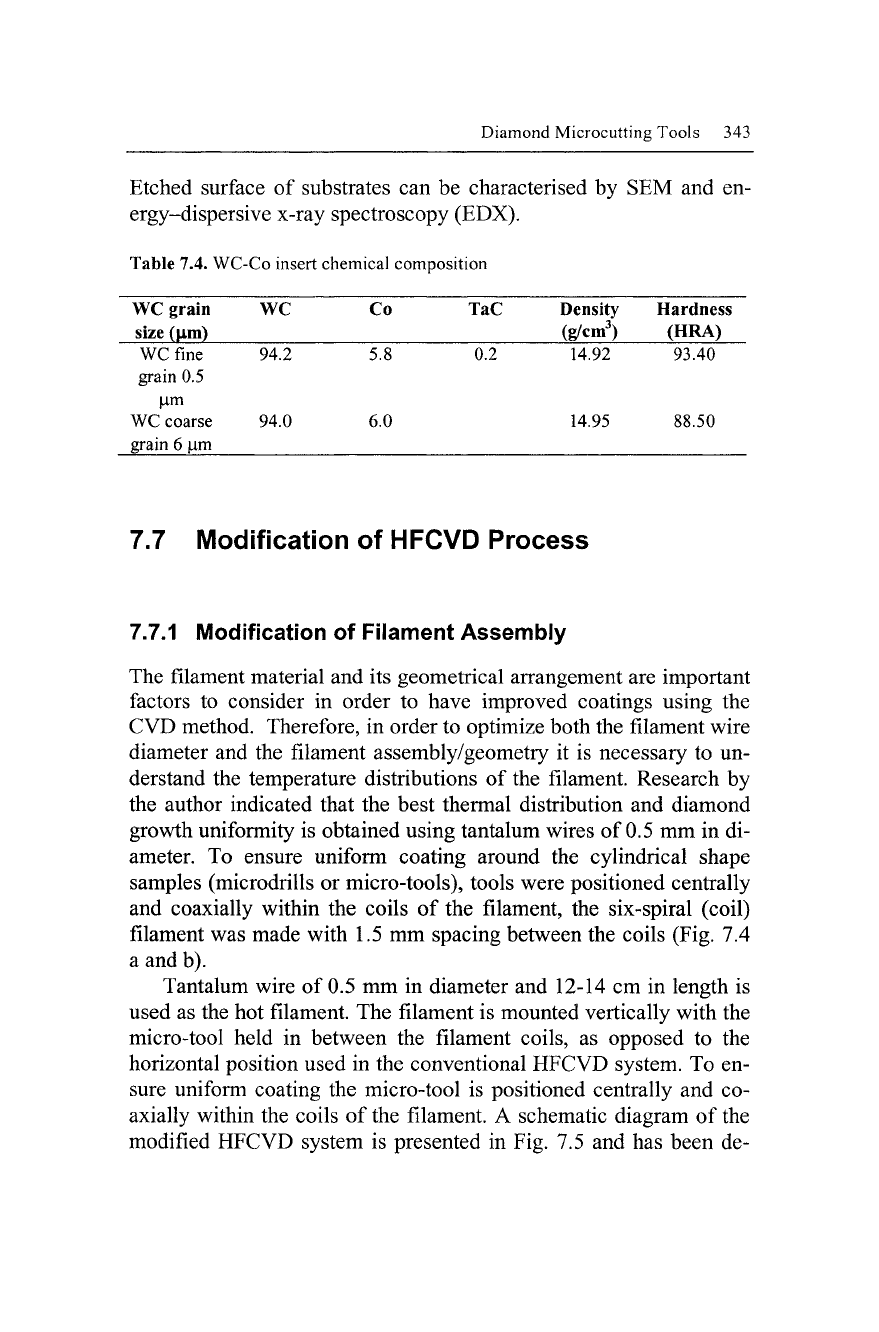
Diamond Microcutting Tools 343
Etched surface of substrates can be characterised by SEM and en-
ergy-dispersive x-ray spectroscopy (EDX).
Table 7.4. WC-Co insert chemical composition
WC grain WC Co TaC Density Hardness
size (tim) (g/cm^) (HRA)
WCfme 94.2 5.8 0.2 14.92 93.40
grain 0.5
|im
WC coarse 94.0 6.0 14.95 88.50
grain 6 iiim
7.7 Modification of HFCVD Process
7.7.1 Modification of Filament Assembly
The filament material and its geometrical arrangement are important
factors to consider in order to have improved coatings using the
C VD method. Therefore, in order to optimize both the filament wire
diameter and the filament assembly/geometry it is necessary to un-
derstand the temperature distributions of the filament. Research by
the author indicated that the best thermal distribution and diamond
growth uniformity is obtained using tantalum wires of 0.5 mm in di-
ameter. To ensure uniform coating around the cylindrical shape
samples (microdrills or micro-tools), tools were positioned centrally
and coaxially within the coils of the filament, the six-spiral (coil)
filament was made with 1.5 mm spacing between the coils (Fig. 7.4
a and b).
Tantalum wire of 0.5 mm in diameter and 12-14 cm in length is
used as the hot filament. The filament is mounted vertically with the
micro-tool held in between the filament coils, as opposed to the
horizontal position used in the conventional HFCVD system. To en-
sure uniform coating the micro-tool is positioned centrally and co-
axially within the coils of the filament. A schematic diagram of the
modified HFCVD system is presented in Fig. 7.5 and has been de-
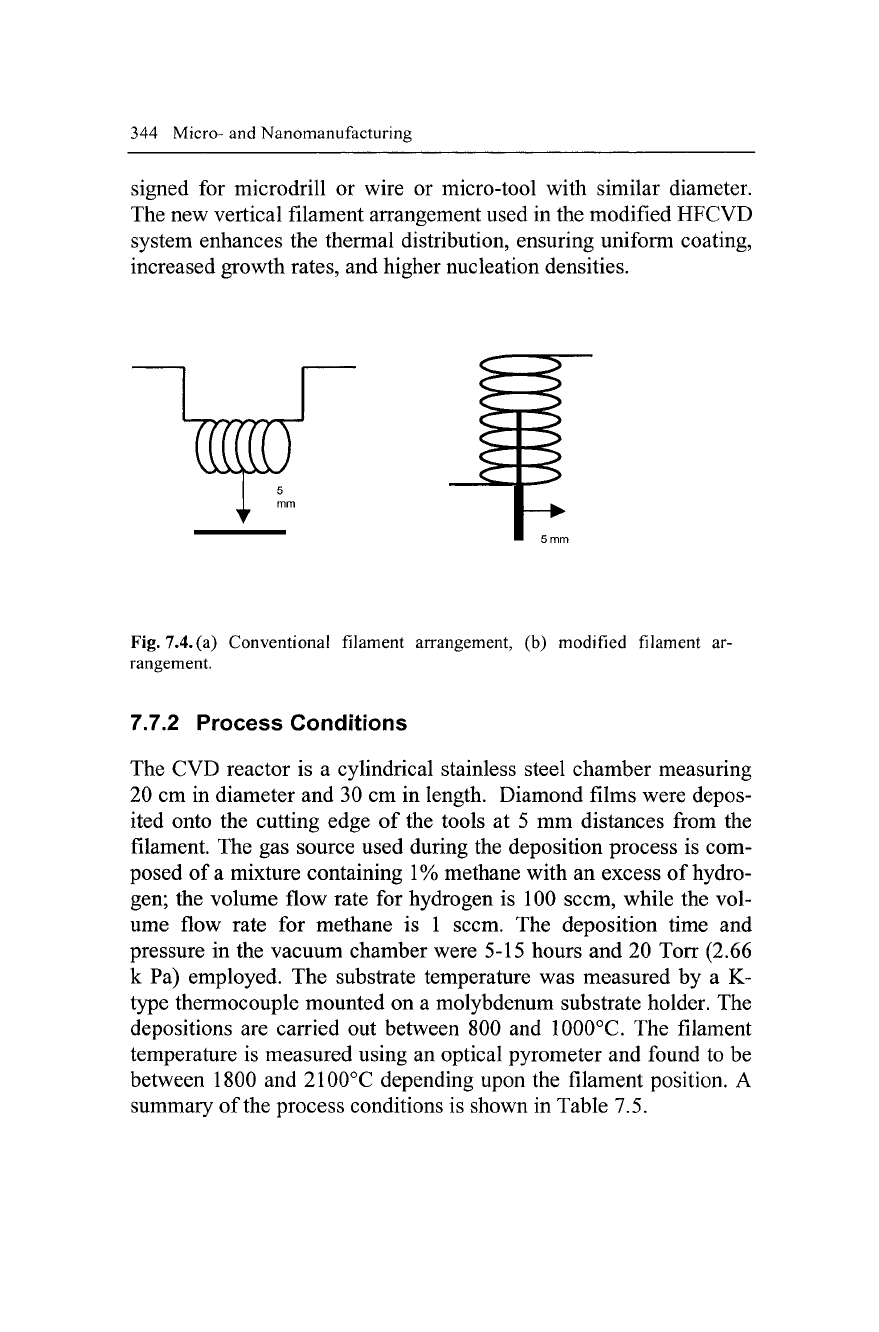
344 Micro- and Nanomanufacturing
signed for microdrill or wire or micro-tool with similar diameter.
The new vertical filament arrangement used in the modified HFCVD
system enhances the thermal distribution, ensuring uniform coating,
increased growth rates, and higher nucleation densities.
5
mm
Fig. 7.4. (a) Conventional filament arrangement, (b) modified filament ar-
rangement.
7.7.2 Process Conditions
The CVD reactor is a cylindrical stainless steel chamber measuring
20 cm in diameter and 30 cm in length. Diamond films were depos-
ited onto the cutting edge of the tools at 5 mm distances from the
filament. The gas source used during the deposition process is com-
posed of a mixture containing 1% methane with an excess of hydro-
gen; the volume flow rate for hydrogen is 100 seem, while the vol-
ume flow rate for methane is 1 seem. The deposition time and
pressure in the vacuum chamber were 5-15 hours and 20 Torr (2.66
k Pa) employed. The substrate temperature was measured by a K-
type thermocouple mounted on a molybdenum substrate holder. The
depositions are carried out between 800 and lOOO^C. The filament
temperature is measured using an optical pyrometer and found to be
between 1800 and 2100°C depending upon the filament position. A
summary of the process conditions is shown in Table 7.5.
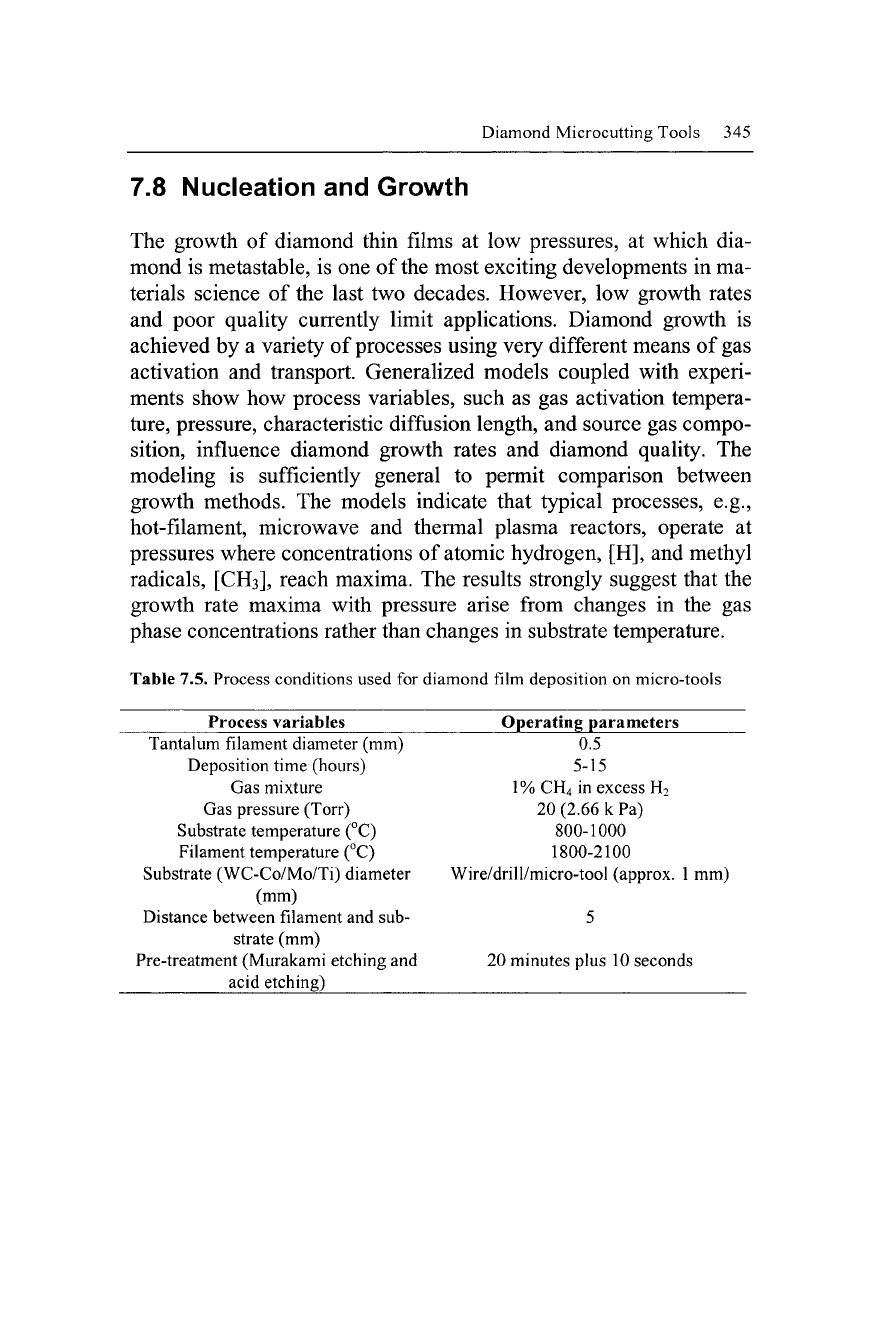
Diamond Microcutting Tools 345
7.8 Nucleation and Growth
The growth of diamond thin films at low pressures, at which dia-
mond is metastable, is one of the most exciting developments in ma-
terials science of the last two decades. However, low growth rates
and poor quality currently limit applications. Diamond growth is
achieved by a variety of processes using very different means of gas
activation and transport. Generalized models coupled with experi-
ments show how process variables, such as gas activation tempera-
ture,
pressure, characteristic diffusion length, and source gas compo-
sition, influence diamond growth rates and diamond quality. The
modeling is sufficiently general to permit comparison between
growth methods. The models indicate that typical processes, e.g.,
hot-filament, microwave and thermal plasma reactors, operate at
pressures where concentrations of atomic hydrogen, [H], and methyl
radicals, [CH3], reach maxima. The results strongly suggest that the
growth rate maxima with pressure arise from changes in the gas
phase concentrations rather than changes in substrate temperature.
Table 7.5. Process conditions used for diamond film deposition on micro-tools
Process variables Operating parameters
Tantalum filament diameter (mm) 0.5
Deposition time (hours) 5-15
Gas mixture 1% CH4 in excess H2
Gas pressure (Torr) 20 (2.66 k Pa)
Substrate temperature (°C) 800-1000
Filament temperature (°C) 1800-2100
Substrate (WC-Co/Mo/Ti) diameter Wire/drill/micro-tool (approx.
1
mm)
(mm)
Distance between filament and sub- 5
strate (mm)
Pre-treatment (Murakami etching and 20 minutes plus 10 seconds
acid etching)
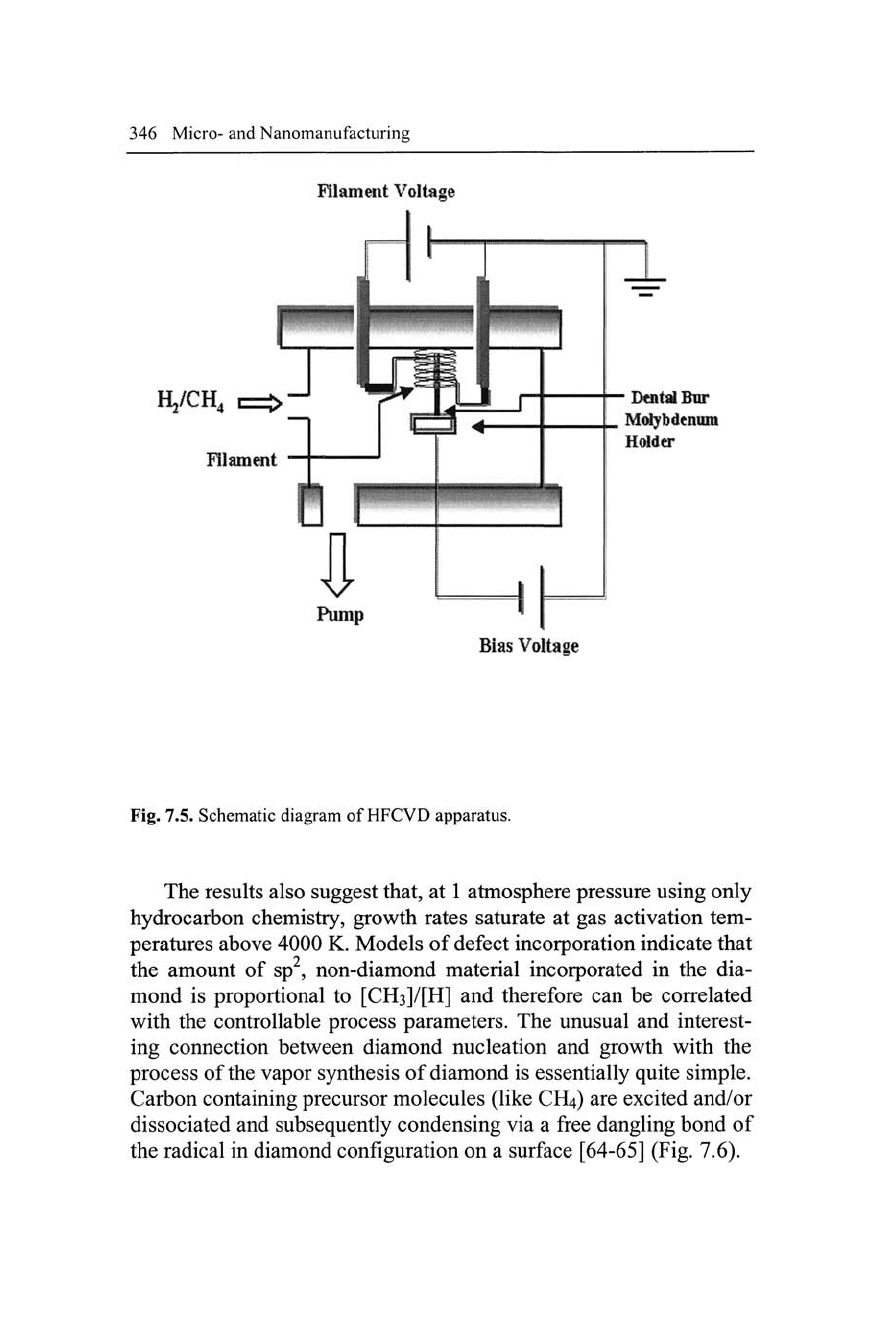
346 Micro- and Nanomanufacturing
Filament Voltage
DaitdBur
Motybdenum
Holder
Bias Voltage
Fig.
7.5.
Schematic diagram of HFCVD apparatus.
The results also suggest that, at
1
atmosphere pressure using only
hydrocarbon chemistry, growth rates saturate at gas activation tem-
peratures above 4000 K. Models of defect incorporation indicate that
the amount of sp^, non-diamond material incorporated in the dia-
mond is proportional to [CH3]/[H] and therefore can be correlated
with the controllable process parameters. The unusual and interest-
ing connection between diamond nucleation and growth with the
process of the vapor synthesis of diamond is essentially quite simple.
Carbon containing precursor molecules (like CH4) are excited and/or
dissociated and subsequently condensing via a free dangling bond of
the radical in diamond configuration on a surface [64-65] (Fig. 7.6).
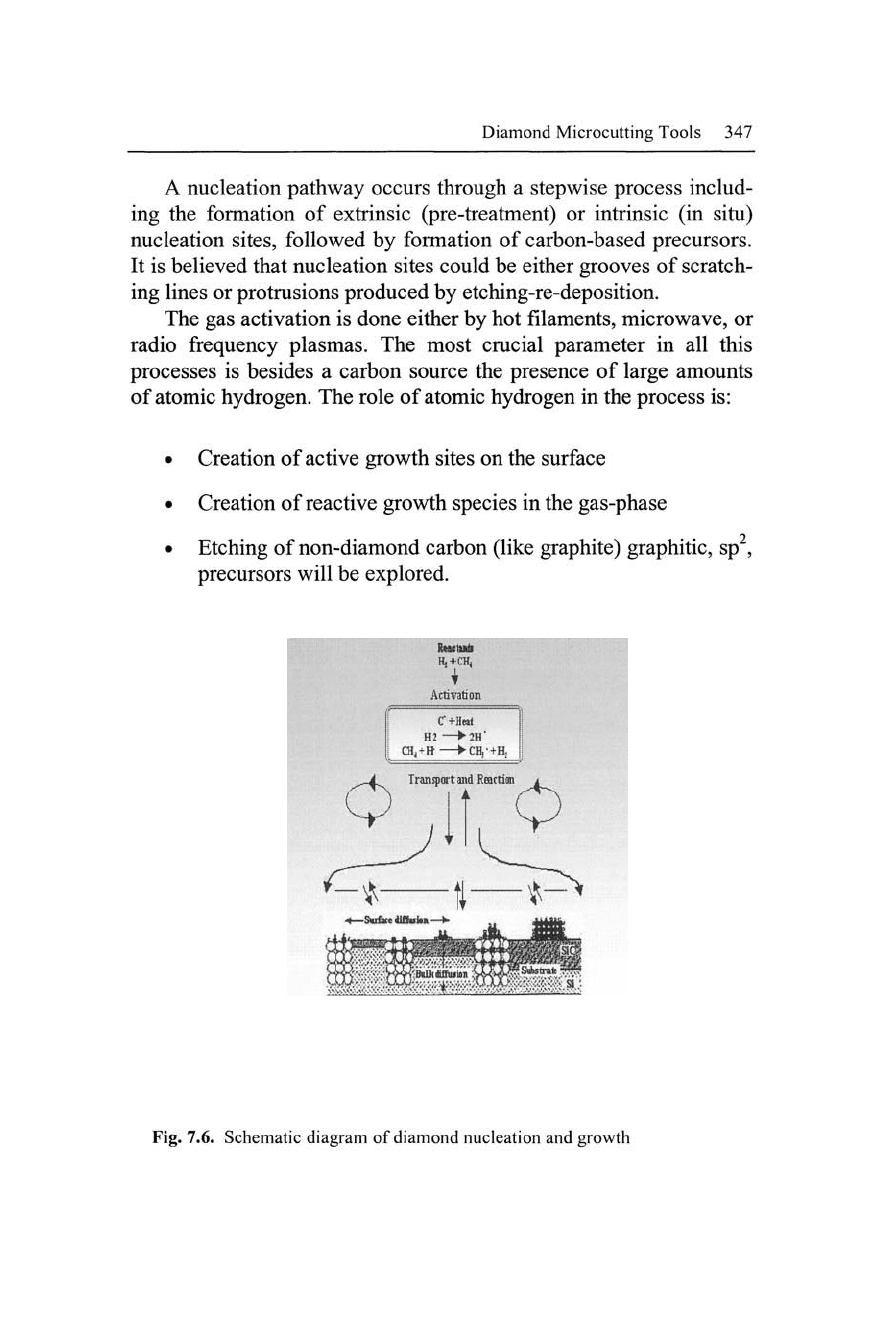
Diamond Microcutting Tools 347
A nucleation pathway occurs through a stepwise process includ-
ing the formation of extrinsic (pre-treatment) or intrinsic (in situ)
nucleation sites, followed by formation of carbon-based precursors.
It is believed that nucleation sites could be either grooves of scratch-
ing lines or protrusions produced by etching-re-deposition.
The gas activation is done either by hot filaments, microwave, or
radio frequency plasmas. The most crucial parameter in all this
processes is besides a carbon source the presence of large amounts
of atomic hydrogen. The role of atomic hydrogen in the process is:
• Creation of active growth sites on the surface
• Creation of reactive growth species in the gas-phase
• Etching of non-diamond carbon (like graphite) graphitic, sp ,
precursors will be explored.
I
H,+CH,
Activation
C*
+Hnt
H2 —•iH"
CHj^H- —•CH3M-H1
Fig. 7.6. Schematic diagram of diamond nucleation and growth
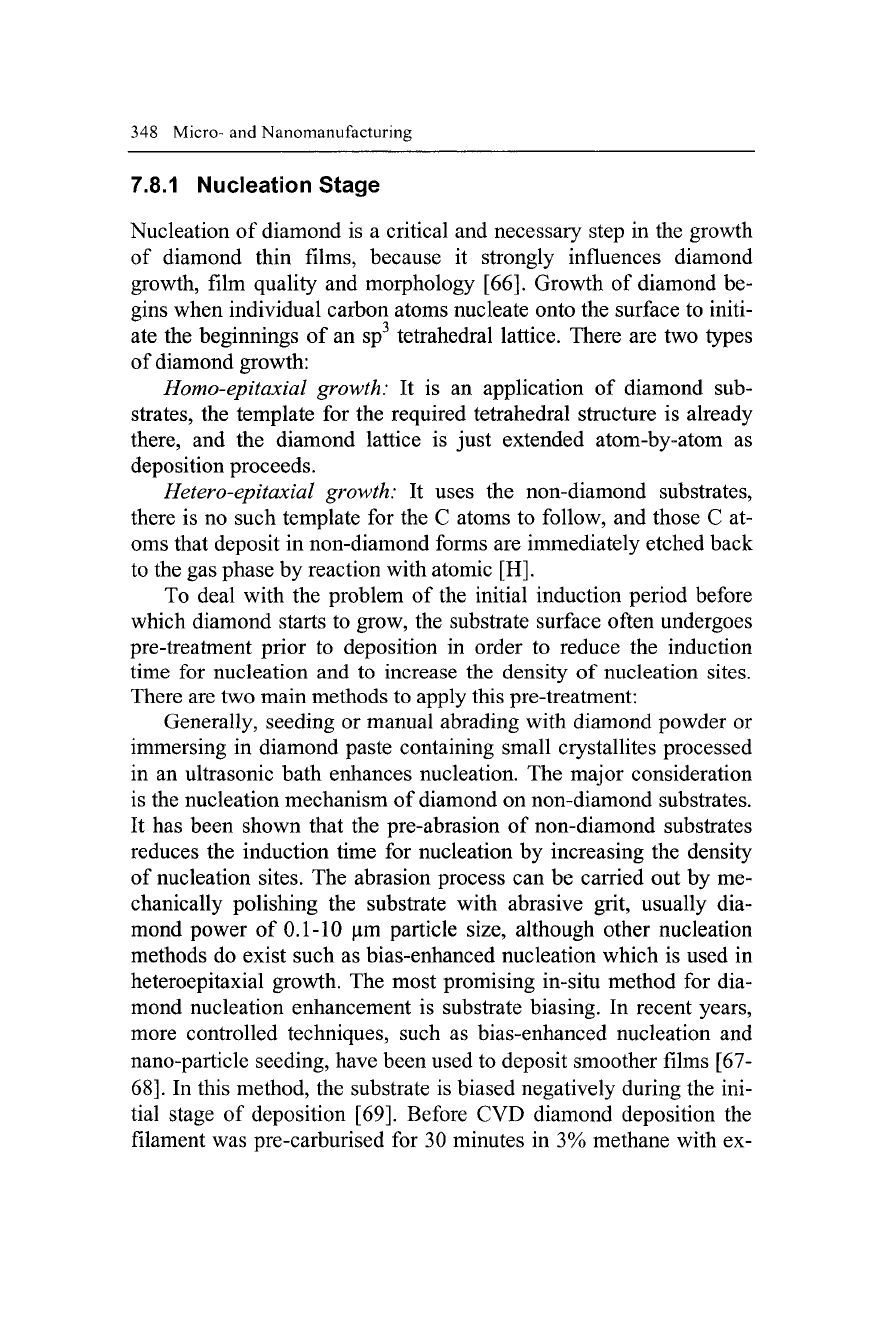
348 Micro- and Nanomanufacturing
7.8.1 Nucleation Stage
Nucleation of diamond is a critical and necessary step in the growth
of diamond thin films, because it strongly influences diamond
growth, film quality and morphology [66]. Growth of diamond be-
gins when individual carbon atoms nucleate onto the surface to initi-
ate the beginnings of an sp^ tetrahedral lattice. There are two types
of diamond growth:
Homo-epitaxial growth: It is an application of diamond sub-
strates, the template for the required tetrahedral structure is already
there, and the diamond lattice is just extended atom-by-atom as
deposition proceeds.
Hetero-epitaxial growth: It uses the non-diamond substrates,
there is no such template for the C atoms to follow, and those C at-
oms that deposit in non-diamond forms are immediately etched back
to the gas phase by reaction with atomic [H].
To deal with the problem of the initial induction period before
which diamond starts to grow, the substrate surface often undergoes
pre-treatment prior to deposition in order to reduce the induction
time for nucleation and to increase the density of nucleation sites.
There are two main methods to apply this pre-treatment:
Generally, seeding or manual abrading with diamond powder or
immersing in diamond paste containing small crystallites processed
in an ultrasonic bath enhances nucleation. The major consideration
is the nucleation mechanism of diamond on non-diamond substrates.
It has been shown that the pre-abrasion of non-diamond substrates
reduces the induction time for nucleation by increasing the density
of nucleation sites. The abrasion process can be carried out by me-
chanically polishing the substrate with abrasive grit, usually dia-
mond power of 0.1-10 |Lim particle size, although other nucleation
methods do exist such as bias-enhanced nucleation which is used in
heteroepitaxial growth. The most promising in-situ method for dia-
mond nucleation enhancement is substrate biasing. In recent years,
more controlled techniques, such as bias-enhanced nucleation and
nano-particle seeding, have been used to deposit smoother films [67-
68].
In this method, the substrate is biased negatively during the ini-
tial stage of deposition [69]. Before CVD diamond deposition the
filament was pre-carburised for 30 minutes in 3% methane with ex-
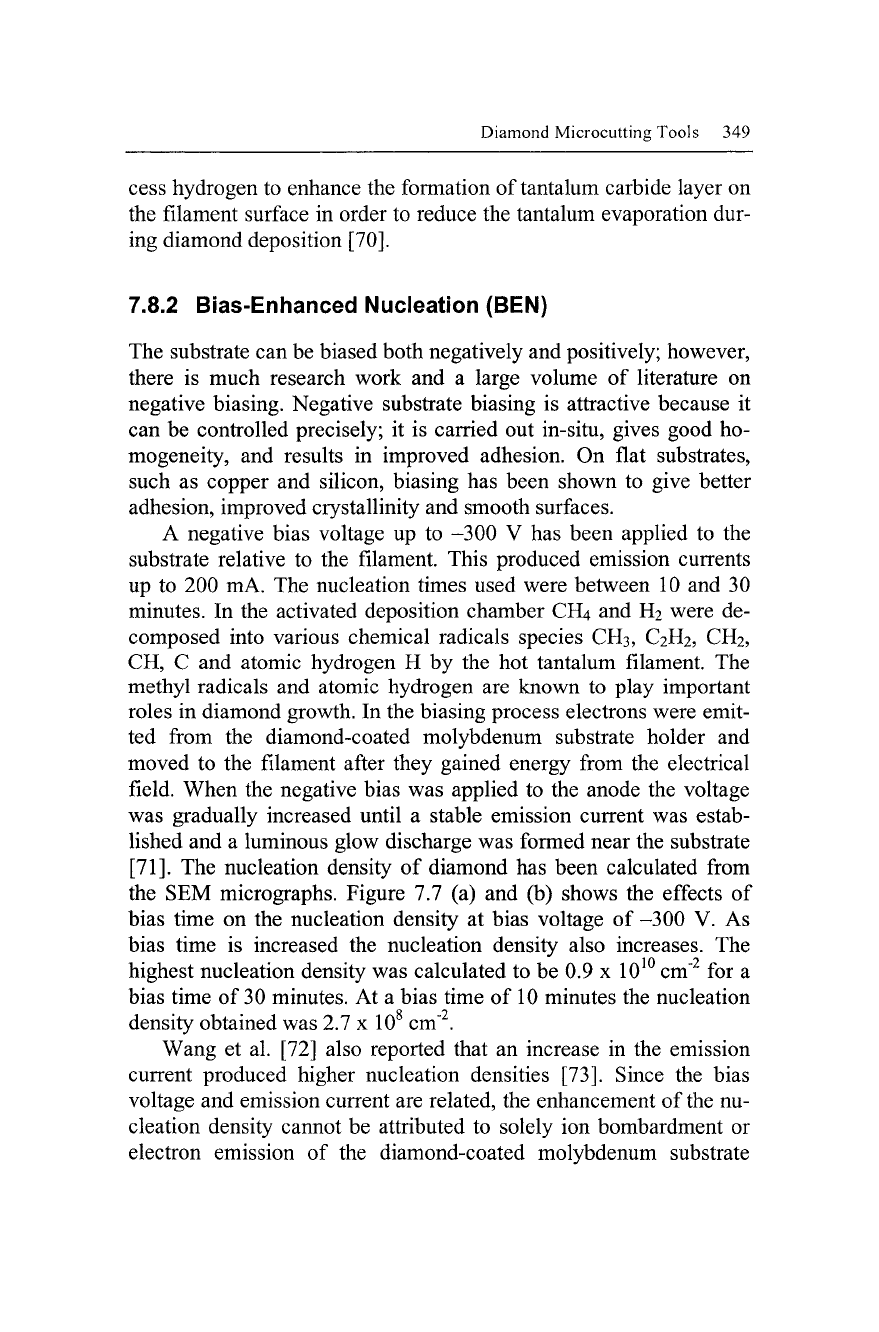
Diamond Microcutting Tools 349
cess hydrogen to enhance the formation of tantalum carbide layer on
the filament surface in order to reduce the tantalum evaporation dur-
ing diamond deposition [70].
7.8.2 Bias-Enhanced Nucleation (BEN)
The substrate can be biased both negatively and positively; however,
there is much research work and a large volume of literature on
negative biasing. Negative substrate biasing is attractive because it
can be controlled precisely; it is carried out in-situ, gives good ho-
mogeneity, and results in improved adhesion. On flat substrates,
such as copper and silicon, biasing has been shown to give better
adhesion, improved crystallinity and smooth surfaces.
A negative bias voltage up to -300 V has been applied to the
substrate relative to the filament. This produced emission currents
up to 200 mA. The nucleation times used were between 10 and 30
minutes. In the activated deposition chamber CH4 and H2 were de-
composed into various chemical radicals species CH3, C2H2, CH2,
CH, C and atomic hydrogen H by the hot tantalum filament. The
methyl radicals and atomic hydrogen are known to play important
roles in diamond growth. In the biasing process electrons were emit-
ted from the diamond-coated molybdenum substrate holder and
moved to the filament after they gained energy from the electrical
field. When the negative bias was applied to the anode the voltage
was gradually increased until a stable emission current was estab-
lished and a luminous glow discharge was formed near the substrate
[71].
The nucleation density of diamond has been calculated from
the SEM micrographs. Figure 7.7 (a) and (b) shows the effects of
bias time on the nucleation density at bias voltage of -300 V. As
bias time is increased the nucleation density also increases. The
highest nucleation density was calculated to be 0.9 x
10^^
cm"^ for a
bias time of 30 minutes. At a bias time of 10 minutes the nucleation
density obtained was 2.7 x 10^ cm"^.
Wang et al. [72] also reported that an increase in the emission
current produced higher nucleation densities [73]. Since the bias
voltage and emission current are related, the enhancement of the nu-
cleation density cannot be attributed to solely ion bombardment or
electron emission of the diamond-coated molybdenum substrate
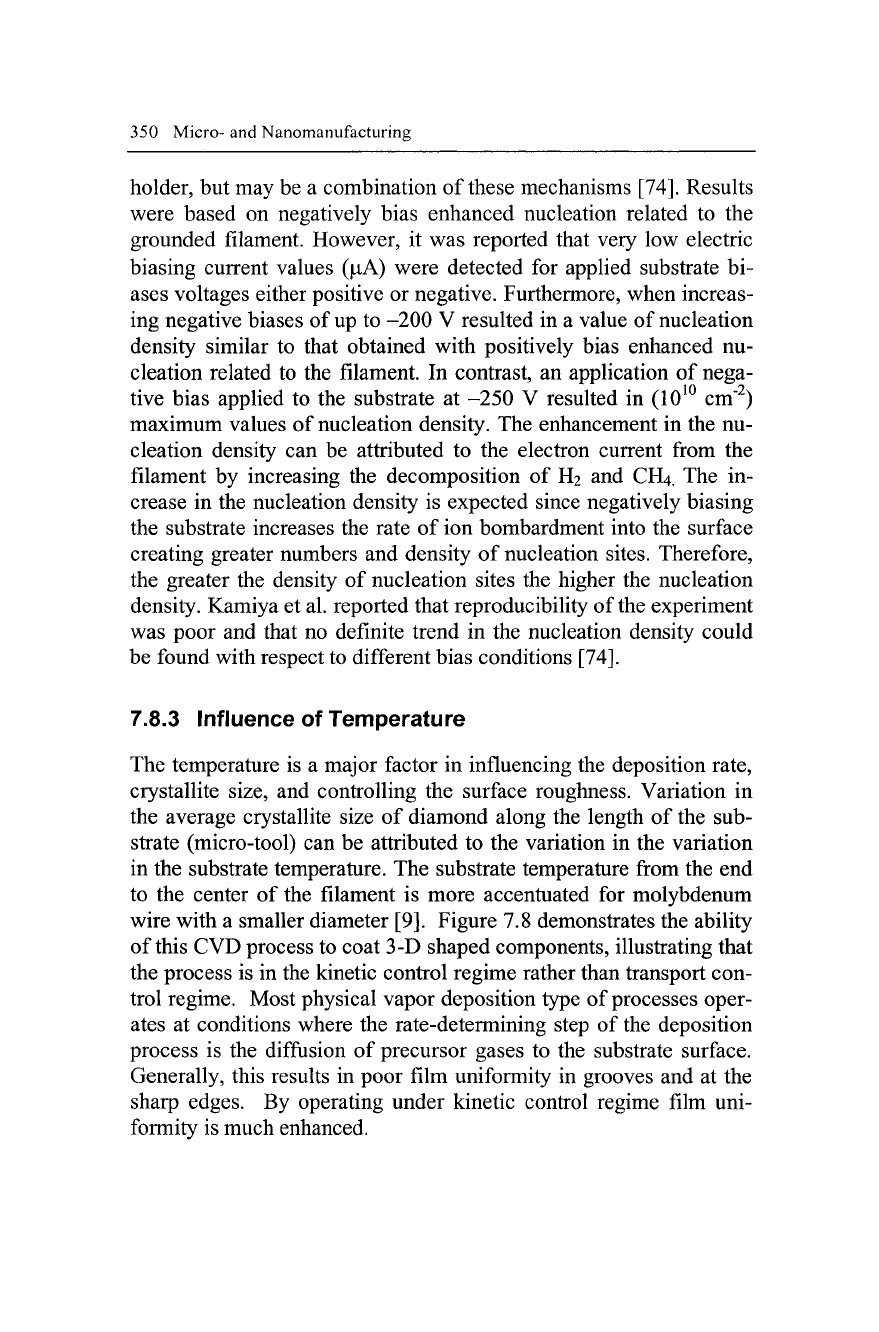
350 Micro- and Nanomanufacturing
holder, but may be a combination of these mechanisms [74]. Results
were based on negatively bias enhanced nucleation related to the
grounded filament. However, it was reported that very low electric
biasing current values
(|LIA) were detected for applied substrate bi-
ases voltages either positive or negative. Furthermore, when increas-
ing negative biases of up to -200 V resulted in a value of nucleation
density similar to that obtained with positively bias enhanced nu-
cleation related to the filament. In contrast, an application of nega-
tive bias applied to the substrate at -250 V resulted in (10^^ cm"^)
maximum values of nucleation density. The enhancement in the nu-
cleation density can be attributed to the electron current from the
filament by increasing the decomposition of H2 and CH4. The in-
crease in the nucleation density is expected since negatively biasing
the substrate increases the rate of ion bombardment into the surface
creating greater numbers and density of nucleation sites. Therefore,
the greater the density of nucleation sites the higher the nucleation
density. Kamiya et al. reported that reproducibility of the experiment
was poor and that no definite trend in the nucleation density could
be found with respect to different bias conditions [74].
7.8.3 Influence of Temperature
The temperature is a major factor in influencing the deposition rate,
crystallite size, and controlling the surface roughness. Variation in
the average crystallite size of diamond along the length of the sub-
strate (micro-tool) can be attributed to the variation in the variation
in the substrate temperature. The substrate temperature from the end
to the center of the filament is more accentuated for molybdenum
wire with a smaller diameter [9]. Figure 7.8 demonstrates the ability
of this CVD process to coat 3-D shaped components, illustrating that
the process is in the kinetic control regime rather than transport con-
trol regime. Most physical vapor deposition type of processes oper-
ates at conditions where the rate-determining step of the deposition
process is the diffusion of precursor gases to the substrate surface.
Generally, this results in poor film uniformity in grooves and at the
sharp edges. By operating under kinetic control regime film uni-
formity is much enhanced.
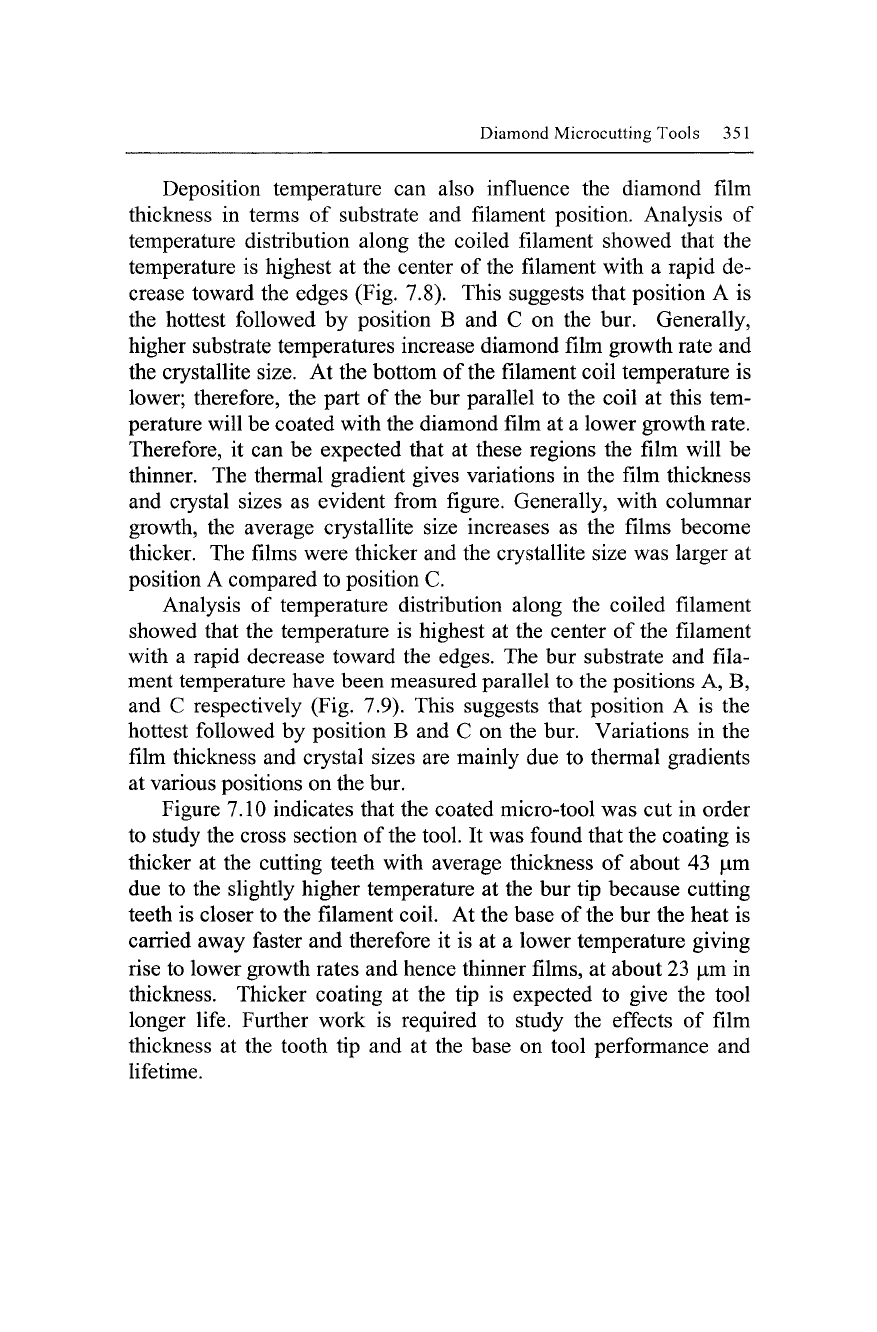
Diamond Microcutting Tools 351
Deposition temperature can also influence the diamond film
thickness in terms of substrate and filament position. Analysis of
temperature distribution along the coiled filament showed that the
temperature is highest at the center of the filament with a rapid de-
crease toward the edges (Fig. 7.8). This suggests that position A is
the hottest followed by position B and C on the bur. Generally,
higher substrate temperatures increase diamond film growth rate and
the crystallite size. At the bottom of the filament coil temperature is
lower; therefore, the part of the bur parallel to the coil at this tem-
perature will be coated with the diamond film at a lower growth rate.
Therefore, it can be expected that at these regions the film will be
thinner. The thermal gradient gives variations in the film thickness
and crystal sizes as evident from figure. Generally, with columnar
growth, the average crystallite size increases as the films become
thicker. The films were thicker and the crystallite size was larger at
position A compared to position C.
Analysis of temperature distribution along the coiled filament
showed that the temperature is highest at the center of the filament
with a rapid decrease toward the edges. The bur substrate and fila-
ment temperature have been measured parallel to the positions A, B,
and C respectively (Fig. 7.9). This suggests that position A is the
hottest followed by position B and C on the bur. Variations in the
film thickness and crystal sizes are mainly due to thermal gradients
at various positions on the bur.
Figure 7.10 indicates that the coated micro-tool was cut in order
to study the cross section of the tool. It was found that the coating is
thicker at the cutting teeth with average thickness of about 43 |Lim
due to the slightly higher temperature at the bur tip because cutting
teeth is closer to the filament coil. At the base of the bur the heat is
carried away faster and therefore it is at a lower temperature giving
rise to lower growth rates and hence thinner films, at about 23 |Lim in
thickness. Thicker coating at the tip is expected to give the tool
longer life. Further work is required to study the effects of film
thickness at the tooth tip and at the base on tool performance and
lifetime.
